Early Harvests and Premium Quality: Southern Africa’s Blueberry Outlook for 2024

In this installment of the ‘Agronometrics In Interviews’ series, Agronometrics studies the state of the Southern Africa blueberry season in an exclusive interview with Dane Castle, Blueberry Technical Sales Manager Southern Africa at Planasa. The series is based on interviews with esteemed professionals from the industry, focusing on a specific origin or topic visualizing the market factors that are driving change.
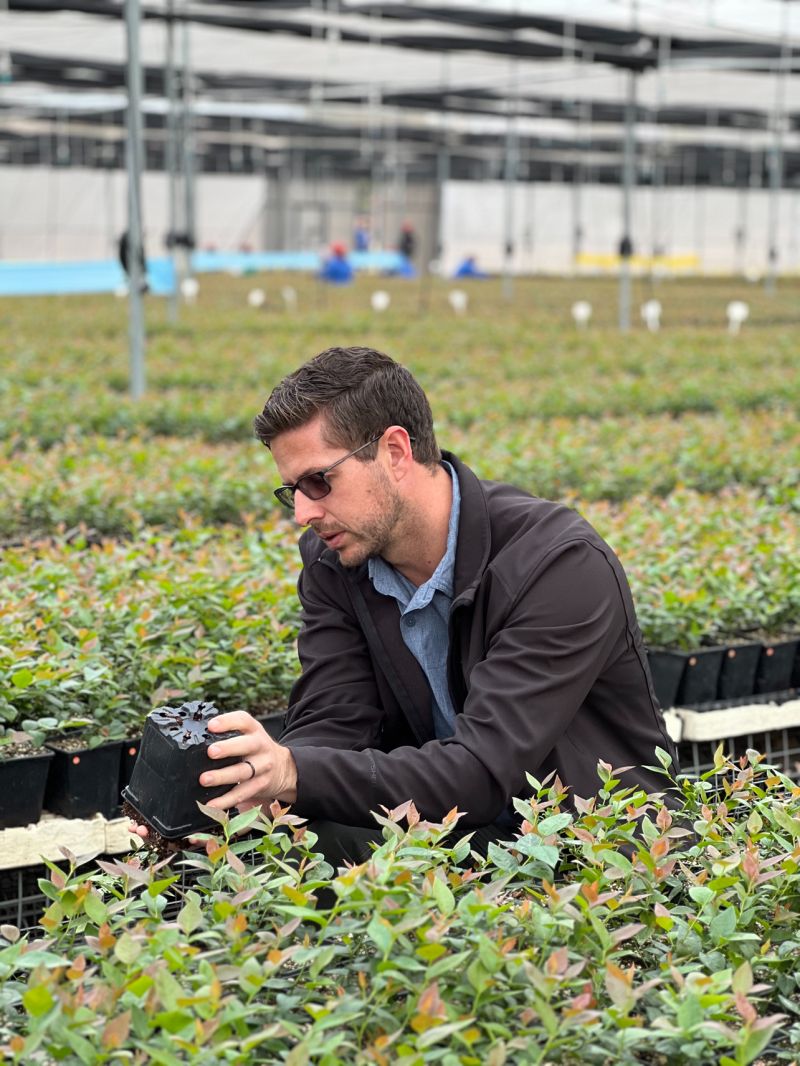
Dane Castle, Blueberry Technical Sales Manager Southern Africa at Planasa.
Could you share insights into the expected volume and quality of blueberry production from Southern Africa for the 2024 season?
In the next week or two, Zimbabwe will experience a significant increase in export volume. Consequently, we anticipate some pressure on air freight departing from Harare. Zimbabwe exports some of its goods from Harare airport and others from Johannesburg airport to handle the high volume of air freight.
Fresh Export Volumes From Zimbabwe | Cultivated All
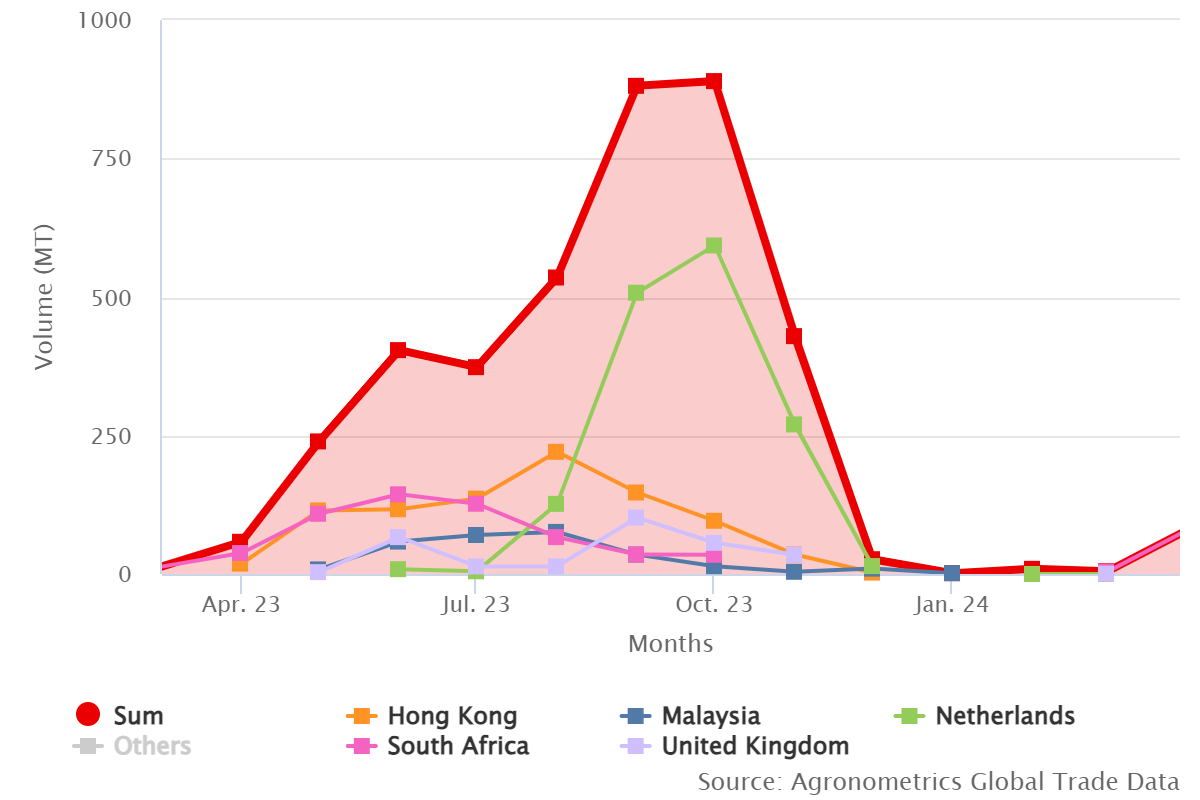
Southern Africa is known for its high-quality produce, and we expect this season to be no different. The Western Cape seems to be running a little earlier this year, possibly by about four to six weeks. But with the winter only setting in now, it’s still too early to tell.
In the north, the volume might arrive a bit later, similar to last year. This delay is primarily due to the older genetic varieties planted there, similar to those in Peru. Warmer or late winters impact these older genetics, delaying the harvest. Blueberries from this area are expected to arrive two to three weeks later. Last year, the volume was lower than expected, but this year we anticipate around 25,000 tonnes of good quality produce as the winter has now set in. However, not everyone declares their volume, so there may be a variation of a few hundred tonnes.
Fresh Export Volumes From South Africa | Cultivated All
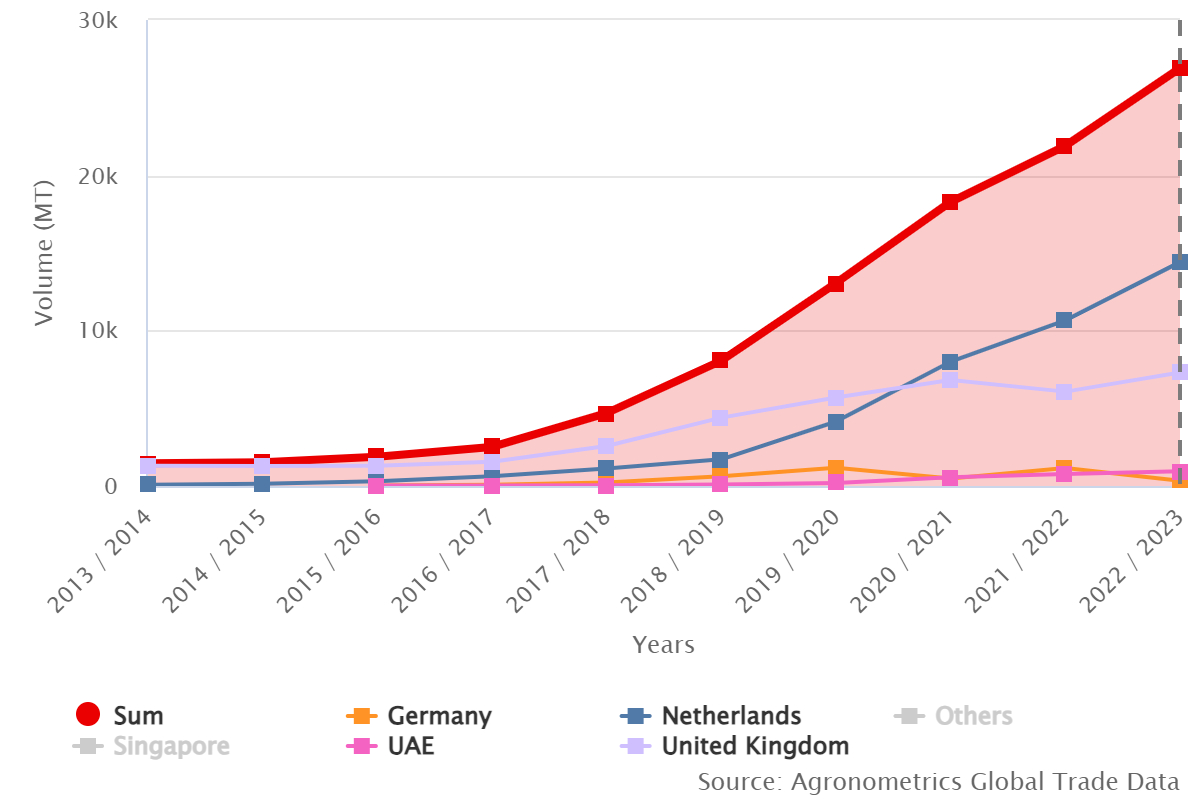
Moderate to warm days with cold evenings are crucial for maintaining quality, and that’s what Southern Africa is known for. We see these conditions occurring this season, which bodes well for the quality of our produce.
What have been and are the challenges of this 2024 season?
I think the biggest challenge for South Africa, and Southern Africa in general, at the moment is logistics, particularly sea freight.
Our harbors, especially Durban Harbour and Cape Town Harbour, have been rated as very poor. They are very inefficient, operating at only 20 to 30% of their potential efficiency. This causes significant delays and poses a huge risk to both quality of the product and performance in the market.
In 2022, port strikes had massive impacts on the industry, resulting in substantial losses for many growers.
There hasn’t been any improvement in the sea freight industry. What’s concerning is that the container terminals are not open to private partnerships or any alternative management. Our ports are entirely state-owned, which is a challenge for the entire fresh export industry, not just for blueberries. The industry is advocating for more private partnerships to allow for investment in training, hiring more workers, acquiring better machinery, and ultimately establishing a more efficient system to expedite exports from South Africa. This situation creates significant difficulties.
Later in the season, even exporters in Zimbabwe have to consider sea freight when air freight becomes too expensive and profit margins shrink. But sea freight is very risky for them. It takes a week for the blueberries to reach the harbor, and then they might sit there for another week. After losing 14 days, they have to hope that the shipment reaches Rotterdam or another destination in 21 days, although it sometimes takes up to 35 days. Adding these delays means their products need a shelf life of 35 to 42 days. After that, they still have to be placed on retail shelves for another 10 days.
Another challenge is the approximately $1,000 increase in some shipping lines, mostly to the Far East, with less impact on shipments to Europe or the UK.
Due to difficulties in Cape Town and Durban, we are now exploring Maputo Harbour in Mozambique. This port has recently received investment led by partners Mozambique Railway Company (CFM), DP World, and Grindrod, MPDC. They dredged the harbour and improved the systems, resulting in significantly better operations.
Some companies, like Driscoll’s, are planning to send their fruit through Maputo Harbour instead of South African ports. This route is mainly for their Middle East and Far East markets, as it is more geographically advantageous. This will be one of the first years where Maputo Harbour is thoroughly tested. Some citrus growers are also using this route, so we will see how it performs.
Currently, most of the industry relies on air freight, particularly early in the season. The biggest challenges with air freight are availability and cost. Many exporters are selling premium jumbo fruit, allowing them to justify the high air freight costs. Last year, due to high demand for air freight, almost everything was shipped this way—probably 90% of the exports, even to Europe. With limited market supply from Peru, we air freighted nearly all our products, making it a hectic season.
This intense reliance on air freight has increased availability and demonstrated the capacity we can handle from our regions.
What are the opportunities of this 2024 season?
In terms of opportunity in 2024, Peru’s shifting production schedule creates significant potential for our market.
Typically, about 50% of Peru’s production occurs in September and October. However, the peak is now shifting more towards October-November, with only about 30 to 40% of the total volume during that period. Additionally, another 30% of the total volume is expected in December-January. This shift benefits South Africa because most of our early growing regions aim to complete their harvest by September-October with a premium crop, ensuring they remain competitive despite Peru’s later peak. The biggest challenge arises for growers in the Western Cape, where most of the supply spans from August to January, directly competing with Peru’s peak production times.
Fresh Export Volumes From Peru | Cultivated All
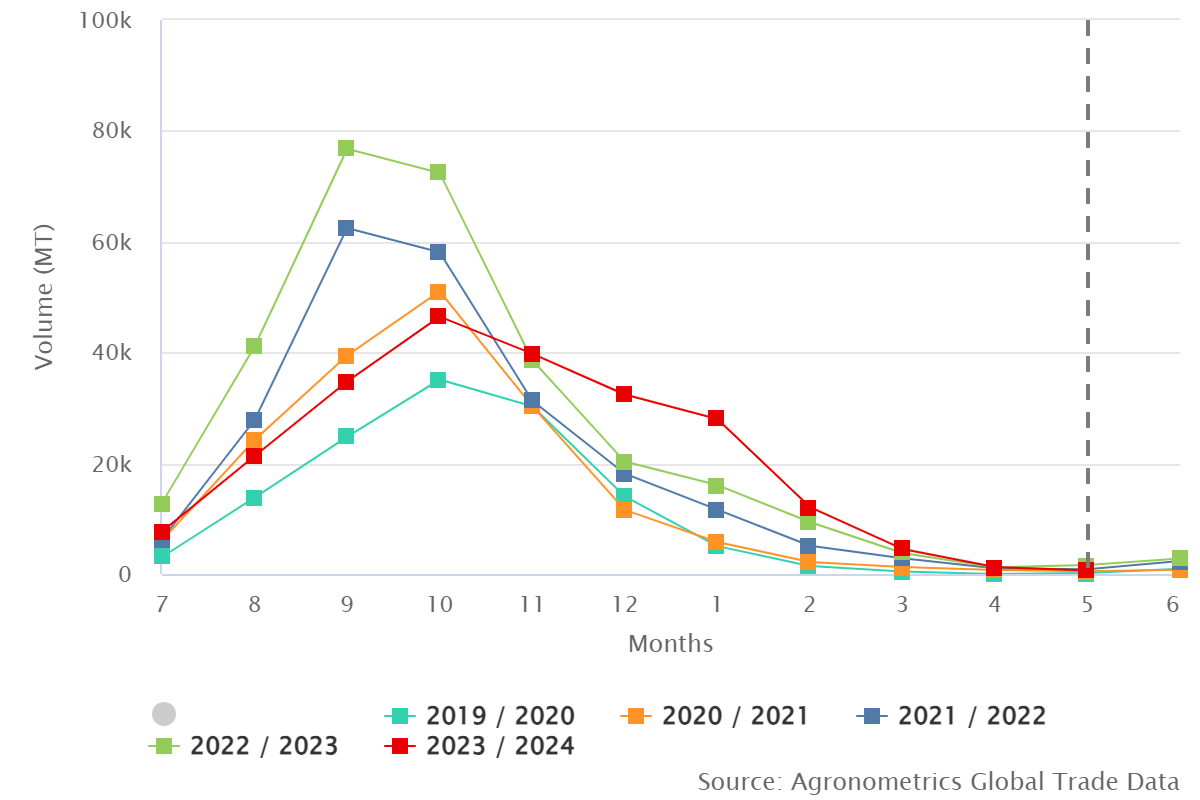
Another opportunity created this season is with the retailers.
Last season’s situation in Peru opened retailers’ eyes to the potential of Southern Africa, highlighting the high quality and premium genetics of our blueberries. This has given us greater recognition on the global blueberry stage.
Retailers, feeling uncertain about relying solely on Peru, are now seeking to diversify their sources. This shift has increased demand for Southern African blueberries. As a result, the biggest opportunity is that we now have higher demand and better prices. This will uplift the industry, support replacement plantings, and allow for the expansion of hectares under cultivation.
The Netherlands and the UK have historically been the main importers of Southern African blueberries. How do you see this evolving in the coming years?
When the blueberry industry started in South Africa, it was mostly dominated by Berry World, which has a strong connection to the UK. Consequently, a significant portion of our hectares was planted with Berry World varieties, primarily supplied to the UK. As long as Berry World remains a key player, the UK will continue to be one of our main destinations. The UK recognizes the high quality of blueberries from South Africa and Southern Africa, consistently looking to our region for their premium sector. Some retailers are already seeking premium varieties from us for about 30% of their shelf space. While a good portion of their supply comes from Peru, they often turn to Southern Africa for top-tier blueberries.
Our supply schedule aligns well with Europe’s blueberry supply chain. Typically, Poland is one of the last countries in Europe to supply blueberries. Before Poland, countries like Turkey, Spain, and Morocco provide their supply. South Africa fits in perfectly after these countries, ensuring a steady and complementary flow of blueberries to the European market.
Additionally, Middle and Far East markets will continue to grow, especially thanks to the quality from Southern Africa. The return prices make it a very encouraging market, particularly for early season fruit from April to the end of July.
What do you think are the competitive advantages of Southern African blueberries for the export market, especially as compared to other countries from the Southern Hemisphere such as Perú?
The biggest advantage Southern Africa blueberries have over Peru is twofold: our timing and our quality.
Some of the very early areas that harvest in April, May, and June primarily send their fruit to the South African domestic market, where prices are very good. This fruit often comes from Zimbabwe. But now, more growers are planting in the northern parts of South Africa, including
provinces like Limpopo, Mpumalanga, and the Northwest. These areas are warmer and experience mild, dry winters, making the harvest season easier and reducing the need for protective plastic coverings.
Most of the growth in blueberry cultivation is currently happening in these northern regions. As a result, we will have increasingly earlier fruit from May onwards. This early fruit is primarily destined for the Far East and Middle East where they receive excellent prices, while we cannot compete logistically with other suppliers to Europe early in the season.
South Africa Fresh Export Price by Partner | Cultivated All
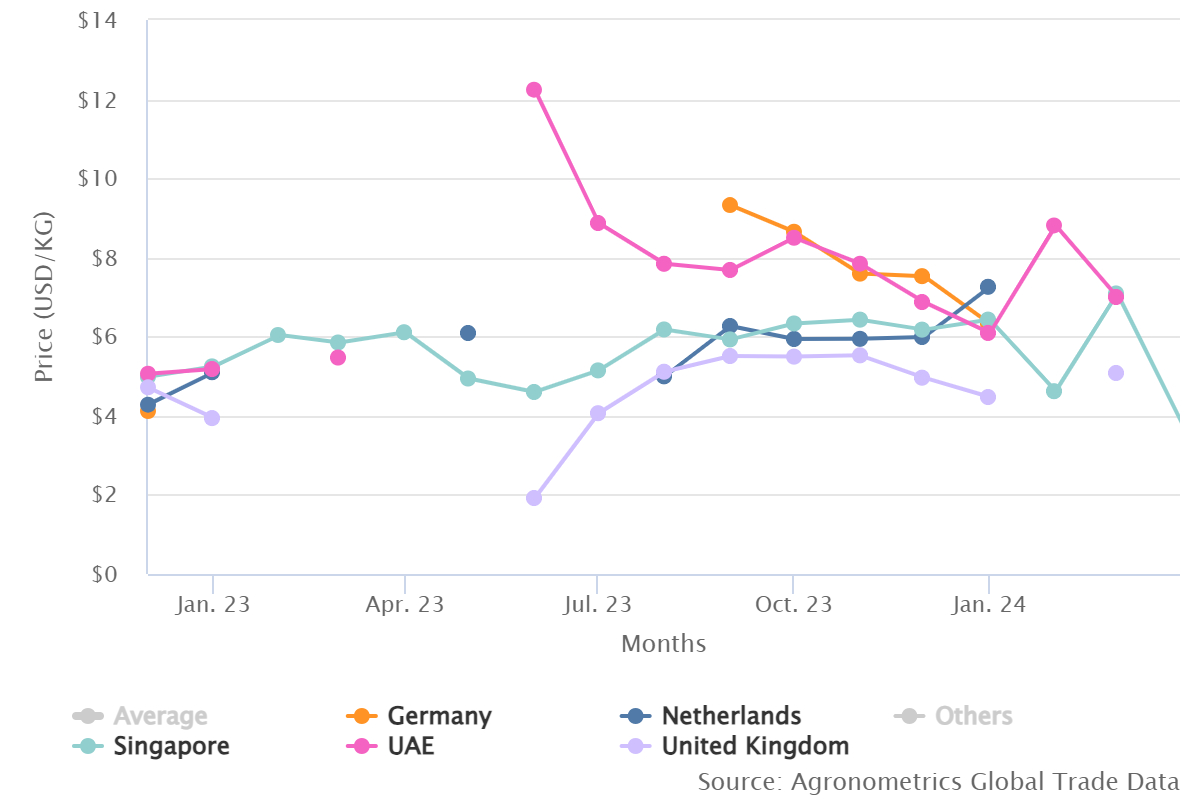
It’s clear that Peru will remain the dominant player in the commodity market due to their vast hectares and high volume. Competing against their scale is unrealistic unless we significantly increase our own hectares, which is a complex undertaking. Currently, South Africa has about 3800 (ref IBO report) hectares planted, while Zimbabwe and Namibia together have about 700 (ref IBO report) hectares. This is just over 30% of Peru’s total hectares.
Therefore, we should allow Peru to dominate the commodity market while Southern Africa focuses on the premium market. Our emphasis on quality is our biggest advantage and driving factor. Maintaining this focus will continue to set us apart and ensure our success in the premium sector.
We are quite up to date with the replacement of varieties and the introduction of new premium genetics in Southern Africa. This has given us a distinct advantage in supplying premium varieties to retailers in Europe, the UK, and even the Middle East. As a result, the competition with Peru is now almost negligible. Peru can dominate the commodity market with lower prices, while Southern Africa focuses on the premium 30%.
The market has recognized this, and we are strategically focusing on maintaining this edge. The demand for premium blueberries is expected to increase, meaning we won’t remain at our current acreage or volume for long.
As time goes by, the consumption of blueberries will continue to rise. This will lead to an increase in Peru’s hectares to meet the demand in Europe and other markets. Similarly, our hectares will also expand to cater to the growing demand for premium blueberries.
So there’s no stress or worry about stagnation in the blueberry market. There’s always the question of the “blueberry bubble”—when will it burst, causing prices to drop or demand to decline? However, if you compare consumption in Europe to the US, European consumption is about a quarter of that in the US. This indicates significant potential for growth. If per capita consumption in Europe increases to match that of the US, demand—and consequently hectares—could increase fourfold.
As long as we focus on producing premium blueberries, we can maintain our price and market share. Given the weaker Rand compared to the Euro, maintaining higher returns allows growers in Southern Africa to keep up with market expansion and inflation. We’ve seen substantial increases in the costs required to develop a farm, and the only way to justify these costs is with better prices for returns.
The price of South African blueberries is usually higher because we are positioned in the premium segment. This premium focus ensures that we can continue to grow and thrive in the market, supporting the ongoing development and sustainability of blueberry farming in Southern Africa.
Written by Thomas






